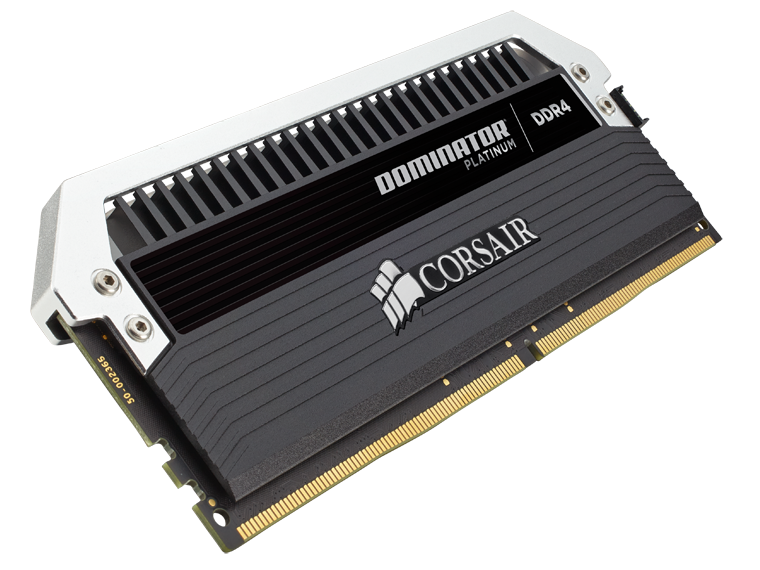Corsair Teams Up With Asus On DDR4; G.SKILL Breaks Record
In addition to all the Haswell-E talk, memory chip makers are coming out to showcase their DDR4 (pdf) solutions as well. One such company is Corsair, which is now shipping Dominator Platinum DDR4 memory kits in 3300 MHz, 3200 MHz and 3000 MHz speeds. These kits are designed to be ideal for Asus’s new X99 motherboards revealed on Friday, as the RAM was developed in close collaboration with the motherboard maker.
“The new Dominator DDR4 memory kits, when paired with the ASUS X99 Deluxe and Rampage V Extreme motherboards, creates some of the fastest, most stable enthusiast PC platforms available for the new Intel Core i7 processors,” the press release said.
According to Corsair, hand-screened ICs were used to build these memory kits. They feature user-swappable colored light pipes, and a cooler operation thanks to patented DHX technology. Their temperatures can be monitored in real-time thanks to Corsair Link compatibility.
Corsair revealed the Dominator Platinum series along with the Vengeance LPX kits on August 15, as we earlier reported.
Meanwhile, HyperX, a division of Kingston, plans to demonstrate its HyperX Predator DDR4 memory kits this weekend during PAX Prime. The actual products will ship sometime in September, and they consist of five 16 GB kits (four DIMMs) starting at 1.2V and clocked at 2133 MHz, 2400 MHz, 2666 MHz, 2800 MHz and 3000 MHz. Like Corsair’s offering, these chips are designed for Intel’s X99 chipset and the Haswell-E processors.
G.SKILL also made an announcement on Friday, reporting that it achieved a DDR4 memory record at 4004 MHz. The company used LN2 extreme cooling, the Asus ROG X99 Rampage V Extreme motherboard and an Intel Core i7-5930K CPU. The score was validated by CPU-Z, the company’s press release said.
The news arrives after G.SKILL recently revealed its Ripjaws 4 Series of DDR4 memory kits. These memory chips include redesigned heat-spreaders in three different colors, extremely low voltages, quad-channel support, and high performance frequencies. These frequencies include 2133 MHz, 2400 MHz, 2666 MHz, 2800 MHz, 3000 MHz and 3200 MHz.
Get Tom's Hardware's best news and in-depth reviews, straight to your inbox.
As we reported earlier this month, ADATA began shipping its DDR4 modules. The company also launched its overclocking memory, the XPG Z1, around the same time.
Follow Kevin Parrish @exfileme. Follow us @tomshardware, on Facebook and on Google+.

Kevin Parrish has over a decade of experience as a writer, editor, and product tester. His work focused on computer hardware, networking equipment, smartphones, tablets, gaming consoles, and other internet-connected devices. His work has appeared in Tom's Hardware, Tom's Guide, Maximum PC, Digital Trends, Android Authority, How-To Geek, Lifewire, and others.
-
fkr I like the quick progres that we are seeing with the speeds. the mits speed is already better for ddr4, now we just have to watch the timing fall and the prices will quickly follow with lowering. It is so nice to finally have some new equipment to lust afterReply -
thefiend1 Im not up on my DDR4 stuff but im wondering - these speeds are so much faster than what the current DDR3 can achieve. Is the "4000" mhz relative, or in the same context, as the prior gen?Reply -
-Fran- Time for a new Socket AMD! Your APUs need DDR4 BAD.Reply
Make the IMC easy to OC as well, please :P
Cheers! -
zanny ReplyIm not up on my DDR4 stuff but im wondering - these speeds are so much faster than what the current DDR3 can achieve. Is the "4000" mhz relative, or in the same context, as the prior gen?
It is not really comparable, because the IPC changed. Latencies are starting at 15, but real world performance varies depending on workload, as per usual.
But 4 gigahertz RAM is still an achievement. It is just that modern CPUs, especially the kind you will see DDR4 used for at first (huge l3 cache 2011s) wiill benefit from ultra-high bandwidth the most because they have the largest FSB data rates, albeit without onboard graphics which is the best utilizer of high bandwidth ram. And even then, it is unlikely we will see a noticeable performance impact. -
fkr Reply14067353 said:Time for a new Socket AMD! Your APUs need DDR4 BAD.
Make the IMC easy to OC as well, please :P
Cheers!
amd is supposed to be making their net chipset work with both ddr 3 and ddr4.
i believe the biggest advantage of ddr4 is that the overall throughput is higher from 1800mits to 2300 or something -
Steve Simons For now the frequency record will have a pretty minimal impact given a lack of built in GPU on the new Haswells. I can see it having a niche place for companies that use large rendering projects requiring massive RAM loads, but obviously this is all good for the future when the timings come down.Reply
The bigger question is what timing benchmark reductions will have to be achieved to drive demand for the product? -
Sakkura Reply
The clocks are directly comparable, and bandwidth is calculated exactly the same way. However, it's not true that these speeds are faster than what DDR3 can achieve. The fastest rated DDR4 modules here are DDR4-3300. Well DDR3-3200 was introduced over a year ago. And the world record for DDR3 overclocking is 4620, while the DDR4 world record is only 4004... for now.14067079 said:Im not up on my DDR4 stuff but im wondering - these speeds are so much faster than what the current DDR3 can achieve. Is the "4000" mhz relative, or in the same context, as the prior gen?
One thing you do have to keep in mind is that latencies tend to be higher for DDR4 than DDR3. Especially comparing at similar clocks. That should also improve over time. -
SessouXFX What I'm curious about is what will Intell plan to do with Broadwell's memory controller next year. Will they stay with the DDR3 or move up to something more up to date?Reply
As for AMD, they said they're still committed to high end computing, but I'll believe when I see it. I'm not holding my breath for them, until they show something that's worthwhile. -
voltagetoe Having high clocks like 3300mhz doesn't mean that the chip is fast - it might actually perform slower than a 2133 DDR3. If only clocks are lifted up - memory performace degrades at some point. I recommend checking out some benchmarks before believing in memory megahertzes.Reply

